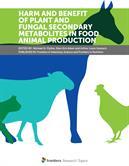Dublin Core
Title
Harm and Benefit of Plant and Fungal Secondary Metabolites in Food Animal Production
Subject
Animals
Description
Livestock species are either herbivores or omnivores that are maintained largely on plant-based diets. We have long appreciated the importance of understanding dietary plants from both nutritional and agronomic perspectives. However, it is increasingly clear that the fungi, bacteria and other microorganisms that live in the plants and animals are also significant factors in the ecology of agricultural animals. Many of the effects exerted on animals by dietary plants are attributable to secondary metabolites produced by the plants themselves or commensal microorganisms. Some fungal and plant secondary metabolites have multiple biological effects. We must be careful not to categorize a plant as strictly beneficial or harmful. Furthermore, we must be careful not to categorize even a particular plant or fungal compound as strictly beneficial or harmful. Rather, the harm or benefit of secondary metabolites are often dependent on the metabolic status of the animal, the interaction with other dietary factors including other secondary metabolites, and the dose received through the diet. This collection examines a range of agriculturally important plant and fungal products including essential oils, alkaloids, isoflavones and nitrates.
URI
URI
Creator
Glen Eris Aiken
Arthur Louis Goetsch
Michael D. Flythe
Source
https://directory.doabooks.org/handle/20.500.12854/49118
Publisher
Frontiers Media SA
Date
2018
Contributor
Nafisa
Rights
https://creativecommons.org/licenses/by/4.0/
Format
pdf
Language
english
Type
text
Identifier
10.3389/978-2-88945-506-5

